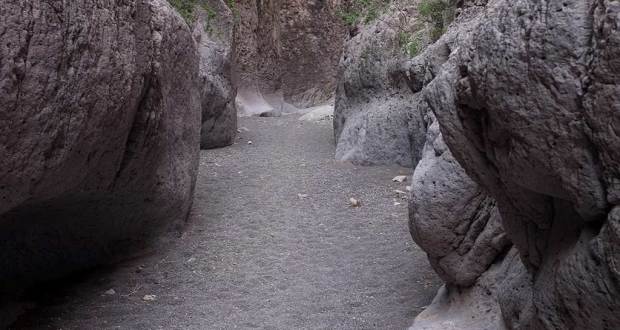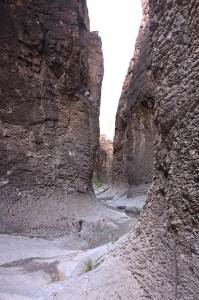At a glance
Distance: 1.4 miles roundtrip
Elevation change: About 100 feet
Hiking time: 45 minutes
Highlights: An intimate walk through a narrow slot between tall walls of volcanic tuff
Difficulty: ★★☆☆☆
Relaxing stroll that requires a bit of clambering over boulders as you get farther in
Trail conditions: ★★★★★
The most shade you’ll see in the park and largely a smooth, flat path
Scenery: ★★★★☆
A narrow slot canyon with walls that seem to climb to the sky
Solitude: ★★★★☆
Big Bend Ranch gets less traffic than most other parks
Other reviews
• Trail diary at TrimbleOutdoors.com
• Closed Canyon Trail on TexasHiking.com
• Photo blog of a canyon hike
The trail begins a short distance from the road and climbs down into a dry creek bed. From a distance, the imposing Colorado Mesa looks impenetrable, but as the creek and trail cross a shallow draw, a crease opens up in the rock.
The light gray floor of the canyon is polished smooth by the torrent of water that occasionally roars through it. Patches of sand and gravel scattered along the path provide the grit that over time grinds down the stone. The patterns of sediment mark depressions where small pools of water gather after a rain. Despite the shade, a few isolated trees and shrubs have managed to grab a foothold in the sand, splashing green against the muted colors of the canyon. They would probably make good apartment plants.The welded tuff of Closed Canyon walls was born in volcanic eruptions in Mexico’s Sierra Ricas that rained hot ash here more than 25 million years ago. Much later, a river flowing over the mesa and into the Rio Grande cut the narrow canyon. The walls are so close in places that you can almost reach out at touch both sides at the same time. It is easy to imagine the predicament you’d face if the water came roaring through while you were standing here.
The hike is a casual stroll at first, but becomes a bit more difficult the deeper into the canyon you go. Big boulders and short dropoffs block your path and require some scrambling. As you decide how far to go, keep in mind that sliding down smooth rock is easier than climbing back up. While the creek eventually pours off into the Rio Grande at the far end of the canyon, it’s not accessible because of a cascade of steep pouroffs at the end of the trail.
The canyon is an intimate space – dark and quiet – compared to the wide expanse and unforgiving sun of the surrounding desert. Its acoustics amplify the scrape your steps through the gravel and the wail of the wind blowing across the sky above. Deserts are solitary places; this is a lonely room within.
• • •







You must be logged in to post a comment.